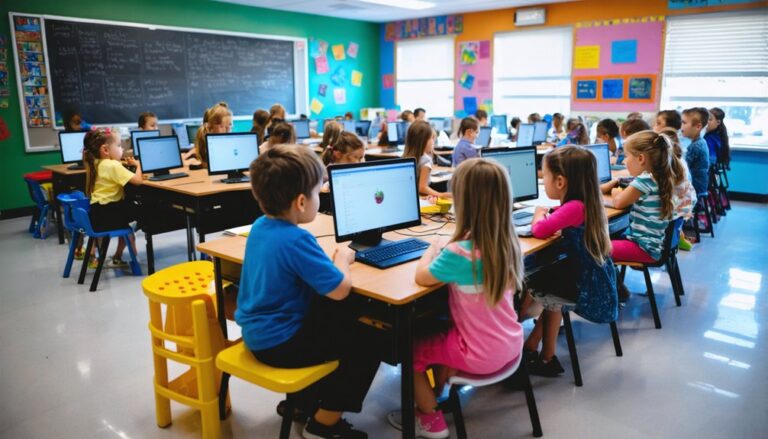Project 2025 proposes significant alterations to U.S. education by planning the closure of the Department of Education. Nearly half of its workforce faces elimination, endangering crucial programs like Pell Grants. It also suggests deep funding cuts, impacting at-risk students, and signals a shift in civil rights enforcement for marginalized groups. Additionally, structural changes in K-12 and higher education may prioritize private options over public schooling. To fully grasp the implications of these changes, further exploration is essential.
Highlights
- Project 2025 aims to close the Department of Education by March 2025, pending Congressional approval, significantly reducing its workforce and operations.
- Major funding cuts could eliminate critical programs like Title I and Head Start, affecting at-risk students and low-income families.
- Proposed changes threaten civil rights protections, particularly for marginalized groups, potentially dismantling enforcement against discrimination in education.
- Structural changes to K-12 education would shift responsibilities to states, risking equitable education standards and resources for disadvantaged learners.
- Higher education policies would see stricter regulations and a push toward privatizing federal loans, impacting affordability and access to college education.
Overview of Federal Department Changes
As the U.S. faces a significant shift in federal governance, the Department Reorganization initiative seeks to close the Department of Education (ED) largely by March 2025, contingent upon Congressional approval, which remains uncertain. This Executive Order reflects the administration’s goal to delegate education responsibilities to states and local entities, promoting community autonomy. Workforce reductions in ED—slashing nearly 50% of its employees—have already impacted key offices, yet the remaining divisions are tasked with continuing essential programs like Pell Grants. A reduction in force has already begun, eliminating nearly 50% of the department’s workforce. The Department’s operations have been impacted by a reduction in force raises concerns regarding the future management of crucial educational functions. Additionally, the 1,400 employees impacted by a non-voluntary reduction in force signify the extensive changes taking place within the department. Stakeholders are encouraged to closely observe these developments as the terrain of federal education evolves.
Funding Cuts and Program Eliminations
The potential funding cuts and program eliminations stemming from Project 2025 signal a significant shift in the terrain of U.S. education, particularly affecting vulnerable populations. The complete elimination of Title I funding could strain education budgets and jeopardize quality instruction for 2.8 million at-risk students. Additionally, proposed changes to IDEA funding threaten essential services for students with disabilities, exacerbating existing disparities. The termination of Head Start and universal free school meals further compromises the support needed for low-income children, potentially increasing food insecurity and limiting early educational development. As educational reform unfolds, these budget cuts could lead to a broader decline in access and equity, disproportionately impacting marginalized communities and raising critical concerns about the future of public education. Furthermore, the loss of 180,300 teaching positions would significantly worsen existing teacher shortages, compounding challenges for students and schools. With the projected phase-out of Title I funding over a decade, the impact on educational quality could be profound. The potential cuts also suggest a shift in focus toward private education instead of supporting public schooling, further jeopardizing equitable access for all students.
Impact on Civil Rights and Equity
Significant changes proposed under Project 2025 pose deep threats to civil rights and equity within U.S. education systems. The initiative suggests dismantling the U.S. Department of Education, risking weakened enforcement of discrimination laws that protect marginalized groups, including Black students and LGBTQ+ youth. By rejecting the disparate impact theory, Project 2025 would hinder addressing policies causing racial disparities, ultimately undermining legal claims for equity concerns. Additionally, rescinding protections for LGBTQ+ students and redefining Title IX could dismantle crucial safeguards against discrimination. This effort to end administrative enforcement of civil rights violations would only exacerbate these issues. Furthermore, the proposal could lead to drastic cuts in funding levels that disproportionately affect schools in Republican-leaning areas.
This path raises alarm for vulnerable populations, heightening systemic inequities and curtailing the hard-fought progress toward inclusive educational environments that enable every student to thrive and belong. The implications of these proposals warrant urgent attention and advocacy for equity. Furthermore, the proposal threatens to exacerbate racial funding disparities, leaving many Black students in underfunded districts without the resources necessary for quality education.
Structural Changes in K-12 Education
Proposed structural changes to K-12 education under Project 2025 are positioned to reshape the educational terrain substantially. By abolishing the U.S. Department of Education, responsibility for federal programs would shift to state and other agencies, likely undermining uniform learning outcomes across the nation. This decentralization risks destabilizing public education systems, affecting efforts to promote equity and inclusion. Further, cuts to vital federal funding, such as the Head Start and Title I programs, threaten resources for disadvantaged learners and could compromise teacher training initiatives. Consequently, these proposed changes not only jeopardize educational quality but also endanger the support systems necessary for fostering diverse classrooms, ultimately impacting the educational experience of all students in the nation. Moreover, the agenda seeks to advance private school choice, which may further complicate the landscape of public education.
Modifications in Higher Education Policies
Modifications in higher education policies have emerged as a focal point of ongoing debates, reflecting a shift in priorities and regulatory structures. These changes encompass significant regulatory reforms, particularly surrounding distance learning and online education, as institutions must now traverse stricter accreditation standards while adapting to hybrid curricula.
Furthermore, the proposed overhaul of student loan policies aims to privatize federal loans, potentially reshaping affordability and access to education. Additionally, executive orders have led to the dismantling of Diversity, Equity, and Inclusion (DEI) programs, affecting how universities approach admissions and student support.
As higher education grapples with these changes, a sense of belonging may become increasingly elusive, necessitating a reevaluation of institutional commitments to inclusivity amidst budget constraints, and further, the sector will need to plunge into the complexities of these issues to find sustainable solutions.
Conclusion
In essence, Project 2025 proposes significant transformations within the U.S. education system, encompassing alterations in federal department structure, funding mechanics, and program services. These changes raise critical concerns regarding civil rights and equity, alongside potential repercussions for K-12 and higher education policies. As stakeholders traverse these proposals, the long-term implications on educational access and quality warrant careful consideration, emphasizing the need for a balanced approach that prioritizes both innovation and inclusivity within the educational terrain to revamp, or in other words, convert the existing educational framework.
References
- https://www.brookings.edu/articles/project-2025-and-education-a-lot-of-bad-ideas-some-more-actionable-than-others/
- https://www.edweek.org/policy-politics/project-2025-what-it-is-and-what-it-means-for-k-12-if-trump-wins/2024/07
- https://tminstituteldf.org/project-2025-threats-to-education/
- https://civilrights.org/resource/trump-project-2025-and-america-first-policy-higher-education-memo/
- https://www.nea.org/nea-today/all-news-articles/project-2025-and-higher-education
- https://www.asha.org/news/2025/whats-next-for-the-u.s.-department-of-education/
- https://www.faegredrinker.com/en/insights/publications/2025/3/new-executive-order-directs-secretary-of-education-to-facilitate-the-departments-closure
- https://www.afterschoolalliance.org/afterschoolsnack/Continued-changes-at-Department-of-Education-as-layoffs_03-12-2025.cfm
- https://www.opb.org/article/2025/02/20/20-shifts-education-trump-administration-government-programs-northwest/
- https://www.whitehouse.gov/presidential-actions/2025/03/improving-education-outcomes-by-empowering-parents-states-and-communities/




